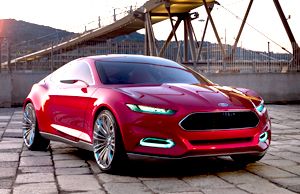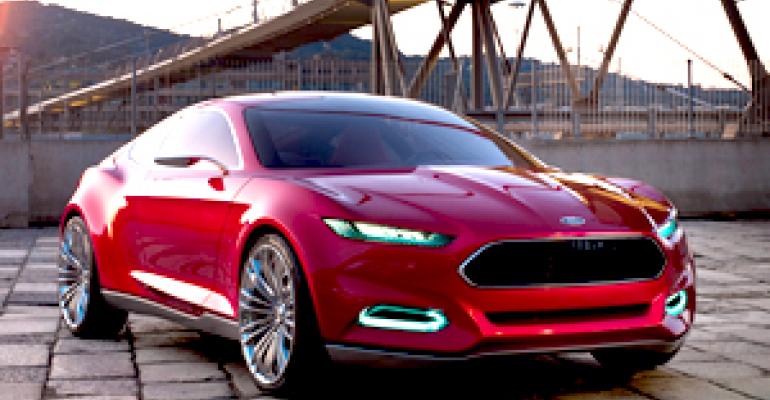
ROCHESTER, MI – Ford’s Evos concept car, set to debut at next month’s Frankfurt auto show, is meant to seduce people, says the auto maker’s design chief.
J Mays, vice president-global design and chief creative officer, also says the Evos is no run-of-the-mill concept, but rather a glimpse at the future of Ford vehicles

“What you see is eight design studios with 1,100 design staff, three executive design directors and the group vice president of design all working very hard on a singular focus on global design DNA that takes us through the next five years,” he says at a media event here.
The Evos is based on design “pillars” devised three years ago by Mays and regional design chiefs Moray Callum and Martin Smith. They include silhouette innovation, perceived efficiency, refined surface language, technical graphics and visual appeal.
The Evos incorporates all of the criteria, from its sleek profile to its “teardrop-shaped cabin,” Mays says. “It separates itself from the rest of the cars you see on the road from other manufacturers.”
Several design features will make it to production vehicles, including the small laser-cut headlamps, he says, noting current headlamps have grown too large and strayed from their intended purpose.
“Headlamps are technical,’ Mays says. “They are supposed to shine light down the road. With the new technology we have, we’re going to go back to laser-cut headlamps. They’re going to be small in height and very stretched out.”
Mays hints that the Evos’ light-emitting-diode headlamps will be a future Ford signature, as will the concept’s trapezoidal grille, which is placed high on the front fascia.
“We’re essentially going from two main grille openings to one smaller opening, which is far more efficient and has a visual ‘premium-ness’ about it,” he says.
But while the market “is littered with manufacturers that have decided to go up-market,” Mays says that’s not the point of the Evos. “I’m talking about delivering to our mainstream customers a visually premium experience. There’s a big difference.”
“(The Evos) has a C-car length, a C/D-car width and is quite low,” Mays says, but it is not destined for production, as evidenced by four gull-wing doors that would be too expensive to mass produce.
The doors are meant to provide Frankfurt show-goers a better look at the car’s interior, which has an L-shape, creating a cockpit feel.
Mays does not reveal which Ford production car will be the first to feature the Evos’ design cues. But the first product will bow in four months, he says, indicating it may be shown at the 2012 North American International Auto Show in Detroit.
The Evos not only hints at future styling but also is the auto maker’s technological showpiece.
“We see technology as more than just an impressive list of microprocessors, sensors and software,” says Paul Mascarenas, chief technical officer and vice president-Ford Research and Innovation.
“It’s about the application of that technology to create an experience that enhances the driver’s time behind the wheel.”
With information provided from The Cloud, the Evos gets to “know” its driver and automatically adapts handling, steering and engine controls from an optimum driving experience, Ford says.
Cloud computing is online shared resources, software and information provided to computers and other devices over a network.
Thereby, the car’s operational systems automatically can play the same radio programming the driver was listening to at home or in the office, heat or cool the interior to an ideal temperature without instructions and close the garage door and switch the lights off as the vehicle pulls away.
The Evos’ powertrain is similar to the one that will move the C-Max Energi plug-in hybrid-electric vehicle slated to launch next year in North America and in Europe in 2013.
But the concept envisions linking the PHEV’s powertrain system to The Cloud, as well. Ford says it could be automatically configured to optimize the combination of the electric motor and gas engine for a given journey.
“Access to historical driver behavior and travel patterns allows us to calculate the optimal fuel and energy efficiency by predicting the destination,” Mascarenas says.
“Our researchers are working to increase understanding of driver behavior, develop accurate protocols to predict it and enhance the trip by providing the smartest use of fuel or battery for the situation.”



